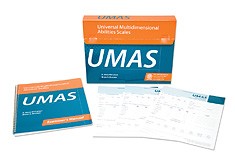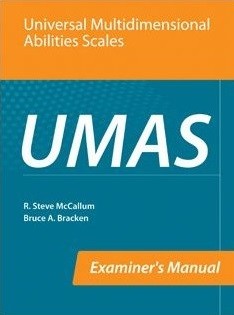*** DISCONTINUED (NO LONGER AVAILABLE) ***
Contents
The Universal Multidimensional Abilities Scales (UMAS) are rating scales designed to screen student behavior in six areas associated with successful school performance: cognition, creativity, leadership, literacy, mathematics, and science. Elevated performance in these areas will characterize students who may be gifted and/or talented; alternatively, limited performance will characterize those who have cognitive and academic limitations, such as intellectual disabilities or learning disabilities.
UMAS was developed to provide the fairest assessment possible. This was accomplished by having raters: (1) focus their ratings on the six areas assessed, rather than on the sophistication of the spoken language used by the student, and (2) consider school, community, and peer standards when rating individual students.
Psychologists, diagnosticians, special educators, and related professionals can use the UMAS to: (1) support a referral for diagnostic assessment, supportive services, or special placements, (2) support a comprehensive evaluation of intelligence, adaptive behavior, and creativity, (3) help practitioners plan interventions by revealing behaviors and skills the teacher considers problematic or lacking, and (4) as a research tool for investigating intelligence, adaptive behavior, and creativity.
The UMAS normative sample is composed of 2,492 students ages 5-0 through 17-11 residing in 22 states. The sample is demographically representative according to U.S. Census projections for 2011. The UMAS has six subscales: Cognition, Creativity, Leadership, Literacy, Math, and Science, each of which can be interpreted independently or combined into a total score, the General Aptitude Index (GAI).
Reliability and Validity
•Internal consistency (content sampling) reliability coefficients exceed .97 for all subscales and is .99 for the GAI.
•Test-retest (time sampling) coefficient for the subscales range from .84 to .96 and for the GAI is .96.
•Correlations of the UMAS GAI with measures of giftedness and achievement are large or very large in magnitude.
•Binary classification studies indicate that the UMAS is able to accurately identify students with low cognitive ability (i.e., sensitivity = .83, specificity = .97, ROC/AUC = .99, cut score = 70, low false positives) and high cognitive ability (i.e., sensitivity = .75, specificity = 1.0, ROC/AUC = .98, cut score = 115, no false positives).
•Considerable other reliability and validity evidence is provided in the manual.

 Proud to be Canadian
Proud to be Canadian

